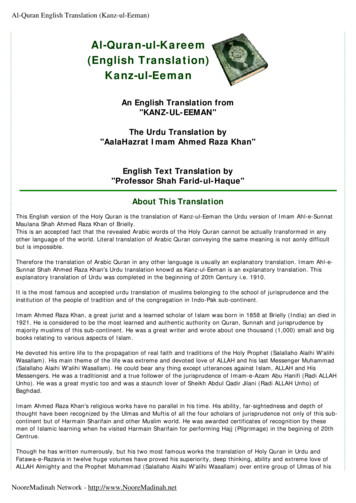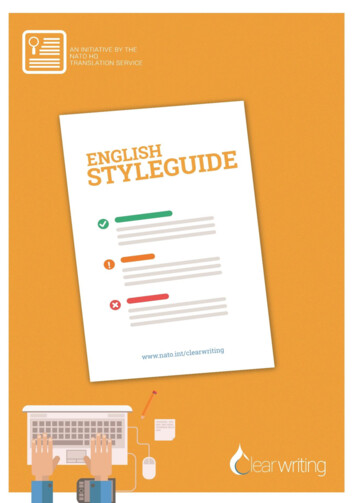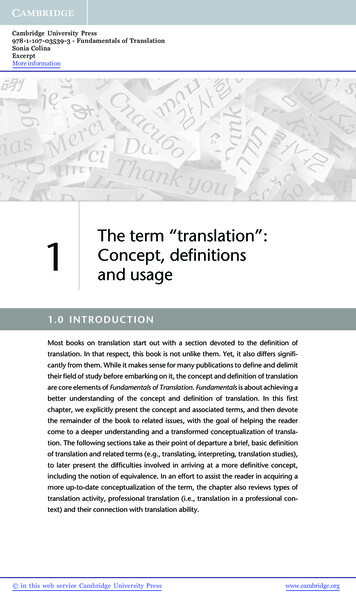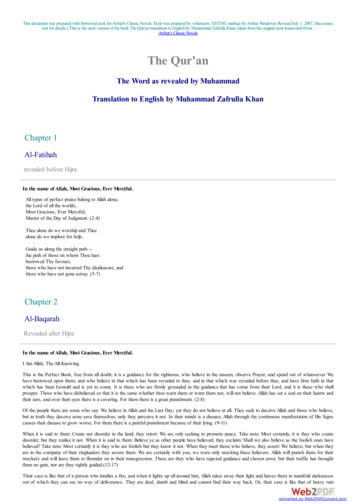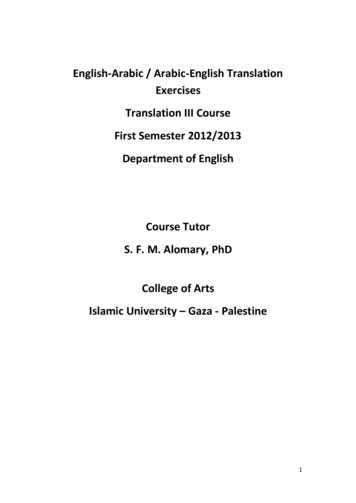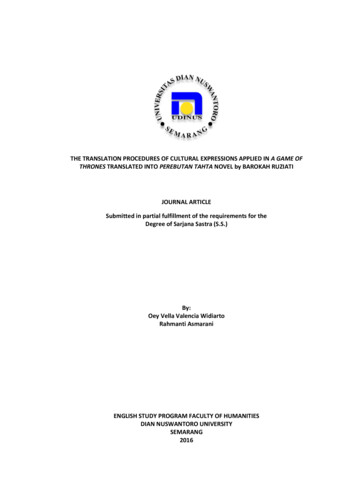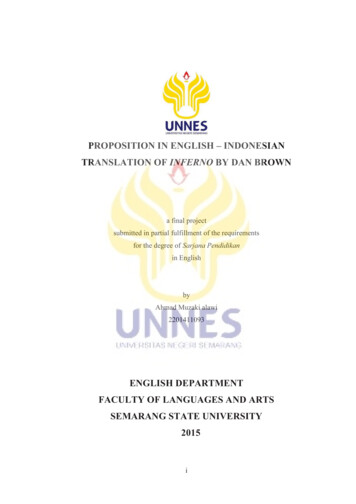
Transcription
PROPOSITION IN ENGLISH – INDONESIANTRANSLATION OF INFERNO BY DAN BROWNa final projectsubmitted in partial fulfillment of the requirementsfor the degree of Sarjana Pendidikanin EnglishbyAhmad Muzaki alawi2201411093ENGLISH DEPARTMENTFACULTY OF LANGUAGES AND ARTSSEMARANG STATE UNIVERSITY2015i
ii
iii
Some live so wrong, with what we do is each His own.But living in fear is endless shame for countless years.(Avenged Sevenfold)To my parents, brothers, and friendsiv
ACKNOWLEDGEMENTFirst and foremost, I would like to express my gratitude to Allah SWT theAlmighty for the blessing, kindness and inspirations in leading me accomplishingthis final project.I realize that I will never complete this final project without the help fromothers. Thus I would like to give my sincerest gratitude and appreciation to Drs.Ahmad Sofwan, M.A., Ph.D. as the advisor for the patience in providing carefulguidance, helpful corrections, very good advices as well as encouragement duringthe consultation. I would like to thank to all my lecturers in English Departmentof Semarang State University for the valuable knowledge, guidance and advicesduring the years of my study. Also, I would like to thank to Rudi Hartono, S.S.,M.Pd. for inspiring me choosing this final project topic.I would like to express my sincerest thanks to my beloved parents and mysister who always give me support with their prayer, patience and love. Specialthanks are also devoted to my beloved friends especially Ozy, Bagus, Betari, forthe support, motivation and beautiful moments we shared together. And also Iwould like to give my big thanks to Akmal, my roommate, though he used todistract me every time but surely I know that he is the first to support.Finally, nothing is perfect and neither is this final project. Any corrections,comments, and criticism for the improving of this final project are always openwelcomed.The Writerv
ABSTRACTMuzaki Alawi, Ahmad. 2015. Proposition in English – Indonesian Translationof Inferno by Dan Brown. Final Project. English Department. Faculty ofLanguages and Arts. Semarang State University. Advisor: Drs. Ahmad Sofwan,M.A., Ph.D.Keywords: Proposition, Event, State, LarsonThe topic of this research is Proposition in the English-IndonesianTranslation of Inferno by Dan Brown. It is highly inspired by the fact that Englishand Bahasa have significant differences especially in the structure construction.While translating we often find those differences and some changes to get the bestconstruction in TL so that it can be understood more easily. Proposition as Larsonsuggests is the theory that I used in this research to explain how the constructionchanges from English to Bahasa. The purpose of this research was to describe theproposition used in the novel entitled Inferno by Dan Brown in both Englihversion and translated version. The methods I employed were first eliciting thedata from the novel, inventorying the data, classifying the data, analyzing the dataand finally reducing the data until I got the valid representative data. The resultshowed that there were 1181 data occurring in this research. 899 eventpropositions and 151 state propositions do not change. 60 event propositionschange into State and 46 State propositions change into Event. The rests, whichare 25, multiplied from one proposition to two or more propositions. Based on theresult, the changes of proposition occur because there are shifts occurring intranslating the novel. Shifts occurring in the data include Structure-shift in formsof the changing of sentence form, split of sentence and the changing of wordorder. The common shift highly occure is Class-Shift in forms of the shifts ofadjective to verb, verb to adjective, adverb to adjective, noun to verb, and verb tonoun.vi
TABLE OF CONTENTSACKNOWLEDGEMENT . vABSTRACT. viTABLE OF CONTENTS . viiCHAPTER 1 . 1INTRODUCTION . 11.1 Background of Study . 11.2 Reasons for Choosing the Topic . 51.3 Research Questions . 61.4 Objectives of the Study . 61.5 Significance of the Study . 61.6 Limitation of the Study . 81.7 Outline of the Report. 8CHAPTER II. 10REVIEW OF RELATED LITERATURE . 102.1 Review of the Previous Study. 102.2 Review of the Theoretical Study. 132.2.1 Definition of Translation. 132.2.2 Kinds of Translation. 182.2.3Grammatical Problems of Translation . 192.2.4 Proposition . 232.2.5 Inferno by Dan brown and Indonesian Translation. 382.3 Theoretical Framework . 39CHAPTER III . 40METHODS OF INVESTIGATION . 40vii
3.1 Object of the Study. 403.1.1 Synopsis . 403.1.2 Biography of the Writer . 413.1.3 The Publisher of the Novel . 433.2 Role of the Researcher . 433.3 Type of Data . 443.4 Procedures of Collecting Data . 443.5 Procedures of Analyzing Data . 473.6 Procedures of Reporting the Results . 48CHAPTER IV . 51RESULTS . 514.2 Results of the Study . 514.2.1 Event – Event Proposition. 534.2.2 State – State Proposition . 594.2.3 Event – State Proposition . 644.2.4 State – Event Proposition . 714.2.5 Added Proposition. 774.3 Discussion . 86CHAPTER V. 86CONCLUSIONS AND SUGGESTIONS . 865.1 Conclusions . 865.2 Suggestions . 87BIBLIOGRAPHY . 89TABLE OF IDENTIFICATION. 91TABLE OF CLASSIFICATION . 148viii
ix
CHAPTER 1INTRODUCTIONThis chapter covers the background of the study, reasons for choosing thetopic, statement of the problem, objective of the study, significance of the study,and the outline of the final project.1. 1 Background of StudyTranslation has become one with people’s life. We can find translationworks all over places: in schools, bus, public spaces even in our own living room.News we read, movies we watch every night, and fictions we own are often thework of translation. Moreover with the technology era, translation is not anymoreexclusively owned by professionals. Like stated by Baker and Gonzales (2011)that increased globalization gives translation and interpreting firm position inpublic consciousness. People become more concern with translation even they canproduce their own works despite the fact that they are not expert in that field.Novel is one of the most literary work that cannot be separated from peoplelife. Many people read novel in their spare time. The characteristic of novels differeach other based on their writers. Novel writers will have specific style in writingnovels. Some of them will put some comedy their novels while writing whereasother will import mistery. Some of them will write romance story whereas otherswill make horror story. Even there are many writers who put culture and history1
2element in their novels. The variousity of novels will never get an end followingthe era and culture.The development of novel itself, whether we realize it or not, is growingmore and more. The influence of globalitation makes people can get novels easily.While reading novel we can get many knowledge and information. If the novel isrelated to the history, we will know history. If the story of novel is about struggle,we will be highly motivated to be struggle. The thirst of knowledge make peopletranslate foreign novels. Reading foreign novel will improve our understandingand knowledge about culture in the abroad.This phenomenon makes the writer interested in analyzing a translationproduct of a novel. The product here is a novel entitled “Inferno” by Dan Brown.It is one of many novels written by him after his succesful and famous novels “theDa Vinci Code”, “Angel and Demon”, “The Lost Symbols”, “Deception Point”,and “Digital Fortress”. The popularity of this novel has spreaded out throughIndonesia even the translation of its book becomes best-seller one.This novel, Inferno, is the newest novel Dan Brown write. Just like hisothers novel, Inferno soon attract the readers especially who have known DanBrown well. With an instant time, the novel becomes best-seller one. A fewmonths after its publication in New York, its translation versions begin. Indonesiais one of the countries that translate this novel into Bahasa.From this point, as it is well-known that rendering best meaning from sourcelanguage to target language is not simple. Many people think that translation isonly about changing the meaning from one language to another language. This
3concept is not completely wrong. Translation indeed deals with many aspects oflanguages including words, text, and even culture where those languages arespoken. One of things which make translation is not simple is the fact that thestructure from source language is defferent with the one existing in targetlanguage. However, by looking to this fact, it is clear that translation work willhave many differences especially in the structure.Firstly, from the definition, translation deals with changing the form ofsource language (SL) into target language (TL). This concept is very basic, asexplicitly stated by Larson (1984), by saying that “translation is basically achange of form. When we speak of the form of a language, we are referring to theactual words, phrases, clauses, sentences, paragraphs, etc., which are spoken orwritten . . . . In translation the form of the source language is replaced by the formof the receptor (target) language.”Larson (1984) then explains it more clearly by giving the definition oftranslation, which is transferring the meaning of source language into thereceptor language. This is done by going from the form of the first language to theform of a second language by way of semantic structure. It is meaning which isbeing transferred and must be held constant. Only the form changes. According tohim, the form refers to the actual words, phrases, clauses, sentences, paragraphs,etc. (surface structure of a language).From the definition we can see that the main point in translation is themeaning. It doesn’t matter if the structures are changed as long as they have thesame meaning in both source language and target language. it is the meaning
4which is being transferred and must be held constant. In translation, scientificallythere is term which is called “proposition”. A proposition is a grouping ofconcepts, one of which is central and the others directly related to the centralconcepts. Which grammatical is used in the translation will depend on the relationamong proposition and how the target language will most naturally express theproposition.Each languages has different way to express the idea. It is impossible thatsorce language will be translated into target language with exactly the same formin constructing sentences. Although the meaning remains the same in bothlanguages, the structures will be different. If the structure is different, the unit oflanguage which is as the central concepts in communication, will be differentfrom the source language. Finally when that central units is different, the result ofproposition, as we cannot deny, will change. this changes and how they occur arewhat the writer would like to analyze.In this research, the writer want to analyze the proposition of novel Infernoby Dan Brown as compared to the English-Indonesian translation of this novel.The research conducted is to describe how the propositions in both sourcelanguage and target language are changed and when those propositions are notchanged.
51. 2 Reasons for Choosing the TopicReading novel is a pleasure work. It is always enjoyable and fun for readingnovel that will increase our imagination to describe thing, place, and the situationin novel. Every single person will has different imagination in describing place,person, and plots in novel. Sometimes, when reading novel, we do not only read itbut we take a part in the story. The good sentences are pushed to the limit to meetthe wish of the readers.The effect of globalization causes such an ease in spreading information. Inthis era we can get everything we want easily. As a result, novel is also effected.Slowly but surely, people start to love reading foreign novel. The popularity ofmany developed country makes people want to know more about them. Novel isone of the ways. The problem occuring is that only few people understand andknow foreign language. How about the others? Translation is the answer to helpthem.Nowadays, many of translation novels become popular in indonesia. Thenumbers of translation novels are too many to mention. Due to Indonesianreaders’ need good translation are a must. Here I want to analyze prpositions ofEnglish-Indonesian translation of Inferno by Dan Brown for the following reason:(1) novel is the most literary work to many people. Many of them are originallydelivered in English. In order that the novel can be accepted in certain targetlanguage, the translator should make novel become acceptable to theaudiences who do not know English.
6(2) By analyzing the proposition in the novel, I want to give the commonestpropositions used in the Indonesian translation.(3) In this research, I would also want to analyze the pattern of how thepropositions arechange in one language to another.1. 3 Research QuestionsThe research questions in this study are:a. What propositions are used in the English-Indonesian translation of Inferno byDan Brown?b. How do the propositions change in the Indonesian Translation of Inferno byDan Brown compared to the ones in English version?1. 4 Objectives of the StudyThe objective of this study are:a. to classify the propositions used in the English-Indonesian translation ofInferno by Dan Brown.b. to describe how the propositions are changed in The English-Indonesiantranslation of Inferno by Dan Brown from the ones in English version.1. 5 Significance of the StudyThere are three kinds of significance of this study. They are theoretical,pedagogical and practical significance of the study.
7The first is theoretical significance of the study. It is hoped that this studyenriches and broadens the theories of translation, especially English-Indonesiantranslation. So, we can more acknowledge the differences of grammatical andlexical constructions between English and Indonesian Also, this study becomes areference of studying and learning translation and becomes one of procedures insolving problems of translation.From the pedagogical significance of the study, it is hoped that this studyprovides theories, practices and analysis for students of translation studies,especially in English Department which will encourage them to conductresearches in translation studies. It is because there are not many translationresearches conducted. Whereas, translation itself has very large scope of study.Also, this study improves the knowledge of translation for teachers and studentsof English Department and people who are interested in translation studies as wellas improves their ability in producing good translation texts. And for theresearchers, this study becomes a reference in translation research.The third significance is practical significance of the study. It is hoped thatthis study provides solution to solve grammatical problems of translation fortranslators. It is because proposition is known as a procedure of translation. Tomake a good translation, one have to know the proposition before renderringthe ,message into target langugae. Also this study provides analytical process oftranslation for researchers who conduct researches in translation studies.
81. 6 Limitation of the StudyThis study focuses on analysis of propositios. Object of analysis in thisstudy is Infeno translated by Ingrid Dwijani Nimpoeno and Berliani MantiliNugrahani, published by Mizan Media Utama. Actually there are 104 chapters ofthis novel. However only 10% of novel will be analyzed to avoid wasting time. Inthis case there are 10 chapters that will be analyzed. However, the goal of thisfinal project is to analyze the proposition, not the understanding of the novel. Thatis why, according to the writer, 10 chapters are more than enough.1. 7 Outline of the ReportThe study consists of five chapters. Each chapter is presented as follows:Chapter I is the introduction, which contains the background of the study,reasons for choosing the topic, statement of the problem, objective of the study,significance of the study, and outline of the report.Chapter II is review of the related literature. This chapter has three parts.The first part discusses the review of the previous study. The second partdiscusses the review of the theorotical. The review of theoretical study providestheories that support this study. There are the description of the definitions oftranslation, kinds of translation, grammatical problem of transalation, the
9definition of proposition, kinds of proposition, how to analyze proposition, andtheorotical framework.Chapter III is the method of investigation, which consists of research design,object of the study, type of data, roles of the researcher, method of data collection,and method of data analysis.Chapter IV is the results and discussion, which consists of the generaldescription and results of the study.Chapter V presents the conclusions and suggestions. This chapter containsthe conclusions of the research and suggestions for the readers.
CHAPTER IIREVIEW OF RELATED LITERATUREThis chapter brings out a further explanation regarding the theories used toanalyze the data in this study. It presents the review of previous studies, thedescription of the definitions of translation, kinds of translation, grammaticalproblem of transalation, the definition of proposition, kinds of proposition, andhow to analyze proposition.2. 1 Review of the Previous StudyResearches about proposition used in translation have been conducted forseveral times. As what the writer told in the previous section that proposition canbe found in every language. The research deals with proposition is usually usedfor proving that sometimes in translation we cannot make the same proposition inboth source language and target language. That is due to the different variousitystructure of languages. Or simply we can say that the structure, however, willchange between two languages; source language and target language. There aremany researches are conducted for analyzing this change. Some of them are whatwill be explained below.In 2013, Betlem Soler Pardo made a study about translation entitled “AnIntroduction to the History and Development of Translation”, in his study, hepointed that in order to be able to translate a text, one has to understand it andanalyzed first. The analysis of the text will deal with proposition. According to10
11him, proposition is a theory of communication that a language without propositionis nonsenese. The problem that translator most find is to find the best meaning inthe target language. But, after he/she has found the meaning, he/she will thinkhow to present the idea or message in the target langugae. That’s why we need toknow the proposition.There are also studies related proposition. It is found IN the final project byRosita Ismiyatiningsih (2003) in her final project entitled “Transposition in theTranslation of J. K. Rowling’s Harry Potter and the Philosopher’s Stone intoIndonesian” and Erwan Prasetyo (2003) in his final project entitled “Transpositionin the Translation of Sidney Sheldon’s Bloodlines into Indonesian”. Both finalprojects have the objective of finding out the transposition that occurs in theIndonesian translation of the novel. The discussion is thoroughly into the changeof structures that occur in TL. The change is caused by the different characteristicof both SL and TL. Some verbal sentences are translated into nom,inal sentences,and vice versa.There is also study about proposition that I take from journal made byFriederike Moltmann & Benjamin Schnieder, entitled Nominalization (2011).They conduct a research about nominalization. The discussion is then aboutdefining Tropes, Event, and State. I just also concern about the last two things;Event and State.According to them, Events have received a lot of attention in linguisticsemantic in recent years and a great amount has been done on it. Events then canbe defined as concrete particulars acting as implicit arguments of the verb. Many
12questions about the ontology of events are left up for debate in the currentdiscussion in linguistic semantics, e.g.: should events be viewed as particular or asgeneric objects (or should both types be posited)? Is the Davidsonian approach, onwhich events act as implicit arguments of verbs, really tenable? Moreover, certaindistinctions among events have been made by linguists without thoroughlyclarifying what the distinctions amount to ontologically. An example from recentsemantics is a distinction between perfective and imperfective nominalizations(Ferret, K. & Soare, E. & Villoing, F. (2010)), which recalls Twardovksy’s (1912)ontological distinction between actions (walking, screaming, dancing) andproducts (walks, screams, dances). A particularly important case of that distinctionis the one between thoughts and thinkings.States have also been intensively studied in linguistic semantics; they areoften the referents of nominalizations of gerunds (John’s knowing, John’s beinghappy). An important topic in the current semantic discussion of states is whetherstates are on a par with events and act as Davidsonian arguments of stative verbs.There is the so-called “stative adverb gap” (Katz 2003): stative predicates such asknow, own, and be adjective do not allow for the range of modifiers thateventive verbs allow for. In particular, they do not allow for location modifiersand manner modifiers, and they cannot form the arguments of infinitivalcomplements of perception verbs. This has been taken to show that stative verbslack an event argument (requiring a different semantics for the correspondingstate nominalizations). Recent work by Maienborn (2007) explains the stativeadverb gap by arguing that the relevant verbs take abstract states as arguments,
13which fall under Kim’s (1976) account of events as opposed to Davidson’s(1967). Some stative verbs (e.g. sleep, stand, sit), as Maienborn shows, do allowfor the relevant modifiers and can form an infinitival complement of perceptionverb, and thus take concrete states (‘Davidsonian states’) as arguments.From the explanation above, we can infer that events is the idea in which thefocus is on the action whereas state focuses besides action.2. 2 Review of the Theoretical Study2.2.1 Definition of TranslationTranslation, by dictionary definition, means the process of changingsomething that is written or spoken into another language (Oxford AdvancedLearner’s Dictionary, 8th Edition). Larson (1984) defines that translation isbasically change of form. Form here refers to the actual words, phrases, clauses,sentences, paragraphs, etc., which are spoken or written. In translantion the formof the source language is replaced by the form of the receptor (target) language.Than he also added that translation consists of transferring the meaning of thesource language int the target language. He emphasize the meaning that istransferred and must be stayed constant in both source and target language. Thistransfer is done by going from the form of the first language to the form of thyesecond language by way of semantic structure.According to Larson’s view, in doing translation there are three steps thatshould be done. First is studying the lexicon, grammatical structure,communication situation, and cultural context of the source language. Second is
14analyzing source language in order to determine its meaning. The last isrecconstructing the same meaning using the lexicon and grammatical structurewhich are appropriate in the target language and its cultural context. The processmay be shown as diagram below:Text to betranslatedTranslatioDiscovertheRe-express themeaningMEANINGHe said that to do effective translation one must discover the meaning of thesource language and use target language forms which express this meaningnaturally. In the last point in defining translation, Larson mentioned that the besttranslation must have three aspects; they are: a) it uses the normal language formsof thereceptor language, b) it communicates, as much as possible, to the targetlanguage speakers the same meaning that was understood by the speakers of thesource language, c) it maintains the dynamics of the original source language text.‘Dynamics” of the original source text means that translation work is expected toevoke the same respons as the source text attempeted to evoke.Juliane House (1997) also stated in her book Translation Quality Assesmentthat to produce the best translation, here are some criteria to be considered. Theyare:
15a.A translation must give the words of original.b.A translation must give the ideas of the original.c.A translation should read like an original work.d.A translation should read like translation.e.A translation should reflect the style of the original.f.A translation should possess the style of the translator.g.Atranslation should read as a contemporary of the original.h.A translation should read as a contemporary of the translator.There are specific characteristics of languages which effect the process oftranslating. First is the characteristics of meaning components. Meaningcomponents are “packaged” into lexical items, but they are packaged differentlyin one language than in another. For example, Indonesian duduk has the samemeaning as sitt down in English. However, these two words have the sammeaning though in English it consists of two words and in Indonesian it is packedin only one word. Many times a single word in the source language will need tobe translated by several words and vice versa. Second, it is characteristic oflanguages that the same meaning will occur in several surface structure lexicalitems (forms). Third, it is further characteristics of languages that one form will beused to represent several alternative meanings (Larson, 1984).In contrast with Larson who emphasizes the definition of translation on theform, Newmark (1988) emphasizes the theory of translation on the meaning. He
16says translati
This novel, Inferno, is the newest novel Dan Brown write. Just like his others novel, Inferno soon attract the readers especially who have known Dan Brown well. With an instant time, the novel becomes best-seller one. A few months after its publicati

